
Add To Favorites
On January 13 a Full Moon and a Full Mars were close, both bright and opposite the Sun in planet Earth's sky. In fact Mars was occulted, passing behind the Moon, when viewed from some locations in North America and northwest Africa. As seen from Richmond, Virginia, USA, this composite image sequence follows the evening lunar occultation before, during, and after the much anticipated celestial spectacle. The telescopic time series is constructed from an exposure made every two minutes while tracking the Moon over the hours encompassing the event. As a result, the Red Planet's trajectory seems to follow a gently curved path due to the Moon's slightly different rate of apparent motion. The next lunar occultation of bright planet Mars will be on February 9 when the moon is in a waxing gibbous phase. Lunar occultations are only ever visible from a fraction of the Earth's surface, though. The February 9 occultation of Mars will be seen from parts of Russia, China, eastern Canada, Greenland and other (mostly northern) locations, but a close conjunction of a bright Moon with Mars will be more widely visible from planet Earth. Growing Gallery: Moon-Mars Occultation in January 2025
2025-01-18 David Bowman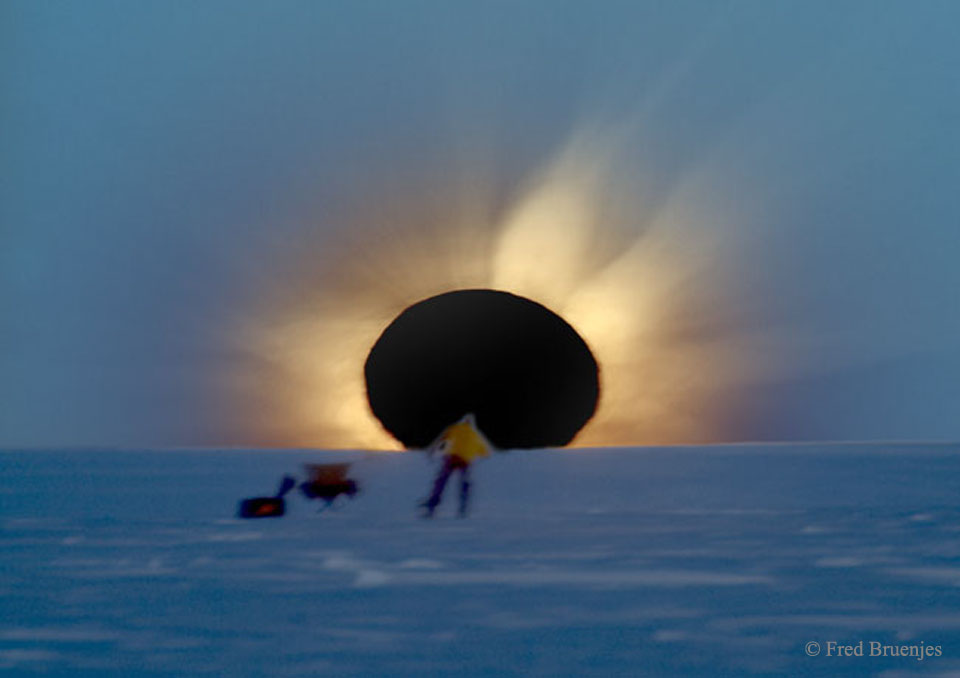
Add To Favorites
Would you go to the end of the world to see a total eclipse of the Sun? If you did, would you be surprised to find someone else there already? In 2003, the Sun, the Moon, Antarctica, and two photographers all lined up in Antarctica during an unusual total solar eclipse. Even given the extreme location, a group of enthusiastic eclipse chasers ventured near the bottom of the world to experience the surreal momentary disappearance of the Sun behind the Moon. One of the treasures collected was the above picture -- a composite of four separate images digitally combined to realistically simulate how the adaptive human eye saw the eclipse. As the image was taken, both the Moon and the Sun peeked together over an Antarctic ridge. In the sudden darkness, the magnificent corona of the Sun became visible around the Moon. Quite by accident, another photographer was caught in one of the images checking his video camera. Visible to his left are an equipment bag and a collapsible chair. A total solar eclipse will occur on Friday and be visible from the north Atlantic Ocean.
2015-03-15 Fred Bruenjes (moonglow.net)Add To Favorites
Have you ever experienced a total eclipse of the Sun? This time-lapse movie depicts such an eclipse in dramatic detail, seen from Australia in 2012. As the video begins, a slight dimming of the Sun and the surrounding Earth is barely perceptible. As the Moon moves to cover nearly the entire Sun, darkness sweeps in from the left -- the fully blocked part of the Sun. At totality, only the bright solar corona extends past the edges of the Moon, and darkness surrounds you. Distant horizons are still bright, though, as they are not in the darkest part of the shadow. At mid-totality the darkness dips to the horizon below the eclipsed Sun, created by the shadow cone -- a corridor of shadow that traces back to the Moon. As the total solar eclipse ends -- usually after a few minutes -- the process reverses and Moon's shadow moves off to the other side. Tomorrow afternoon's total solar eclipse -- visible as at least a partial eclipse over all of North America -- can be experienced at social gatherings, some of which are being organized by local libraries. Tomorrow's Eclipse: Live NASA Streaming Video
2017-08-20 Colin Legg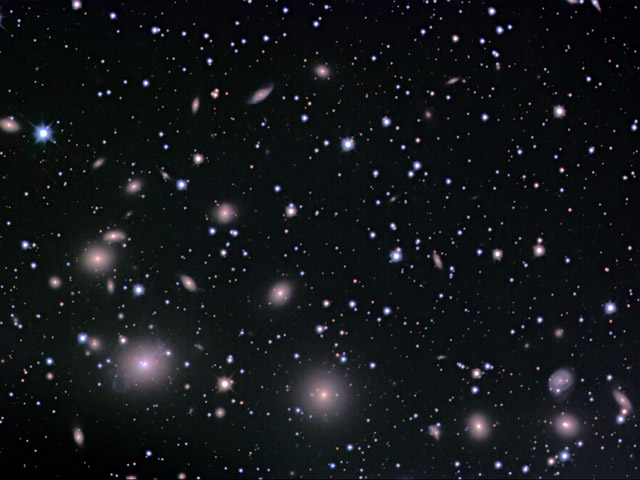
Add To Favorites
Here is one of the largest objects that anyone will ever see on the sky. Each of the fuzzy blobs in the above picture is a galaxy, together making up the Perseus Cluster, one of the closest clusters of galaxies. The cluster is seen through the foreground of faint stars in our own Milky Way Galaxy. It takes light roughly 300 million years to get here from this region of the Universe, so we see this cluster as it existed before the age of the dinosaurs. Also known as Abell 426, the center of the Perseus Cluster is a prodigious source of X-ray radiation, and so helps astronomers explore how clusters formed and how gas and dark matter interact. The Perseus Cluster of Galaxies is part of the Pisces-Perseus supercluster of galaxies, which spans over 15 degrees and contains over 1000 galaxies.
2004-10-25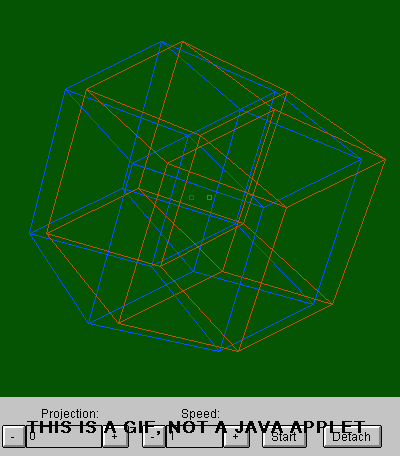
Add To Favorites
Does our universe have higher but unusual spatial dimensions? This idea has been gaining popularity to help explain why vastly separated parts of our universe appear so similar, and why the geometry of our universe does not seem to result naturally from the amounts of matter it seems to contain. The idea is also prevalent in modern attempts to combine gravity and quantum mechanics that include M-theory (formerly string theory) and Randall-Sundrum theory. Such models involve branes and bulks and frequently attempt to explain, among other things, why some quantum energies and the measured cosmological constant are so small. Above, a dynamic three-dimensional drawing (two spatial plus one time) of a four-dimensional depiction of a five-dimensional cube (a hypercube with four spatial dimensions is also known as a tesseract) is shown. Donning red-blue glasses will give the best multi-dimensional perspective. News: A partial solar eclipse will occur tomorrow.
2007-03-18 Mark Newbold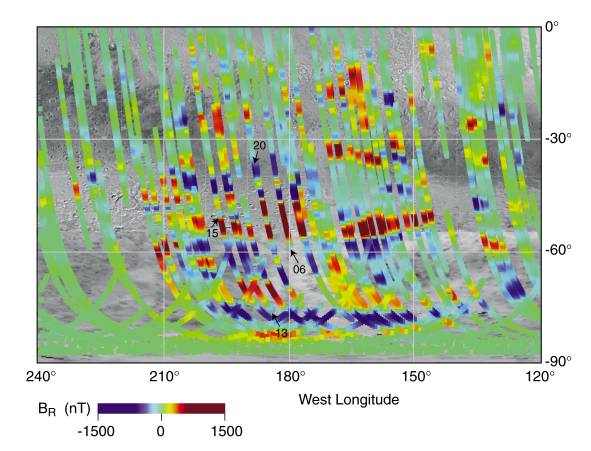
Add To Favorites
Mapping Mars from orbit, instruments on the Mars Global Surveyor (MGS) spacecraft have recently revealed banded magnetic field patterns - a startling and unanticipated suggestion that the Red Planet was more Earth-like in its distant past. The red and blue regions within the MGS orbital tracks across this portion of southern Mars indicate adjacent areas of crust where magnetic fields point in opposite directions. The bands seem to run east-west and are about 100 miles wide and 600 miles long. Such patterns are known to be produced on Earth by plate tectonics. As the crustal plates spread apart along the mid-ocean ridges, they carry a progressive banded record of Earth's changing magnetic field. The similar patterns on Mars are seen as evidence that it too once had moving crustal plates and a changing magnetic field, although both processes - still active on the larger planet Earth - are thought to have long since died away. These high resolution measurements of martian magnetism were made possible by the revised, close aerobraking orbits of the MGS spacecraft and not originally planned.
1999-05-04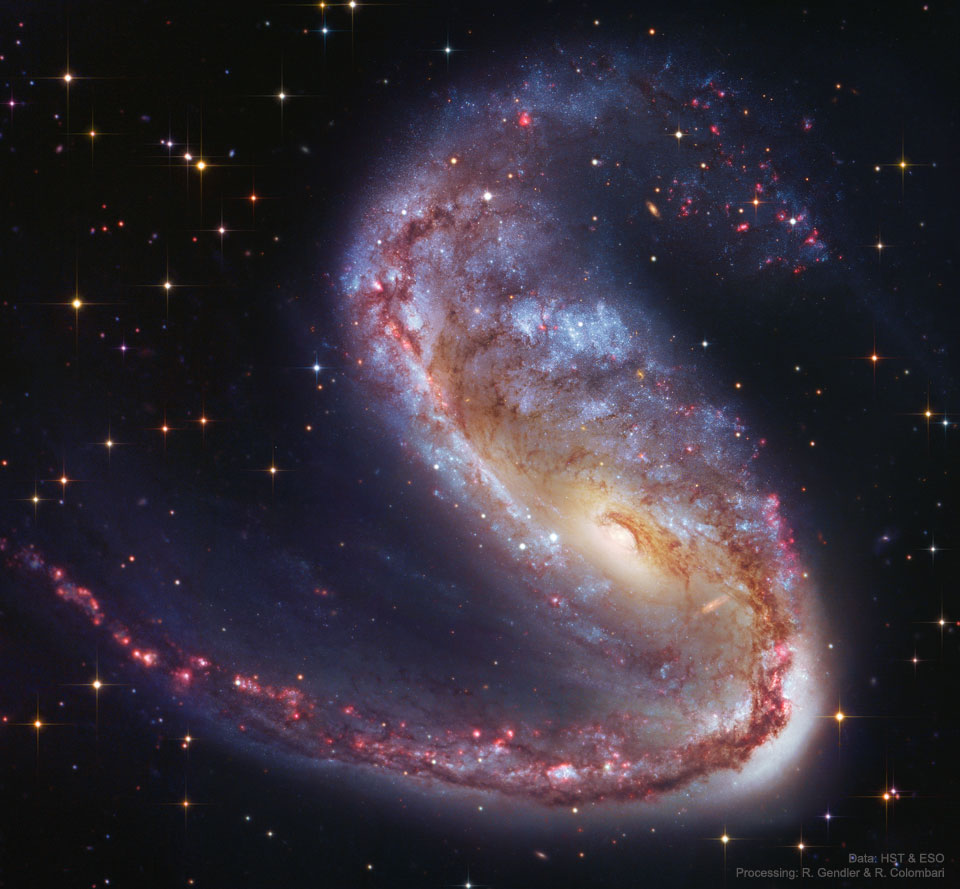
Add To Favorites
Distorted galaxy NGC 2442 can be found in the southern constellation of the flying fish, (Piscis) Volans. Located about 50 million light-years away, the galaxy's two spiral arms extending from a pronounced central bar have a hook-like appearance in wide-field images. But this mosaicked close-up, constructed from Hubble Space Telescope and European Southern Observatory data, follows the galaxy's structure in amazing detail. Obscuring dust lanes, young blue star clusters and reddish star forming regions surround a core of yellowish light from an older population of stars. The sharp image data also reveal more distant background galaxies seen right through NGC 2442's star clusters and nebulae. The image spans about 75,000 light-years at the estimated distance of NGC 2442.
2020-08-04 Robert Gendler
Add To Favorites
Shells and arcs abound in this false-color, multiwavelength view of supernova remnant N63A, the debris of a massive stellar explosion. The x-ray emission (blue), is from gas heated to 10 million degrees C as knots of fast moving material from the cosmic blast sweep up surrounding interstellar matter. Radio (red) and optical emission (green) are brighter near the central regions where the x-rays seem to be absorbed by denser, cooler material on the side of the expanding debris cloud facing the Earth. Located in the neighboring galaxy known as the Large Magellanic Cloud, the apparent age of this supernova remnant is between 2,000 and 5,000 years, its extended glow spanning about 60 light-years. The intriguing image is a composite of x-ray data from the orbiting Chandra Observatory, optical data from the Hubble Space Telescope, and radio from the Australia Telescope Compact Array.
2004-01-01
Add To Favorites
It's back, and it's bigger than ever. The ozone hole that has been a cause of concern in recent years has again reformed over Earth's South Pole. The seasonal recurrence of the ozone hole was expected, although the size of the hole has never been so large this early in the season. Ozone is important because it shields us from damaging ultraviolet sunlight. Ozone is vulnerable, though, to CFCs and halons being released into the atmosphere. The ozone hole's large size is probably related to unusually low temperatures, allowing CFC byproducts like chlorine to react with atmospheric ozone molecules with greater efficiency. In the above false-color picture taken earlier this month, low ozone levels are shown in blue.
1998-10-14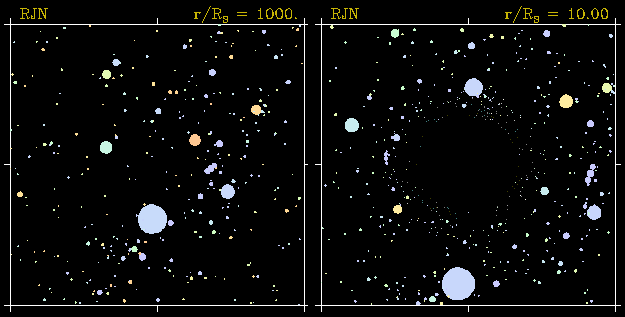
Add To Favorites
What would you see if you went right up to a black hole? Above are two computer generated images highlighting how strange things would look. On the left is a normal star field containing the constellation Orion. Notice the three stars of nearly equal brightness that make up Orion's Belt. On the right is the same star field but this time with a black hole superposed in the center of the frame. The black hole has such strong gravity that light is noticeably bent towards it - causing some very unusual visual distortions. In the distorted frame, every star in the normal frame has at least two bright images - one on each side of the black hole. In fact, near the black hole, you can see the whole sky - light from every direction is bent around and comes back to you. Black holes are thought to be the densest state of matter, and there is indirect evidence for their presence in stellar binary systems and the centers of globular clusters, galaxies, and quasars.
2000-12-10 Robert Nemiroff (MTU)